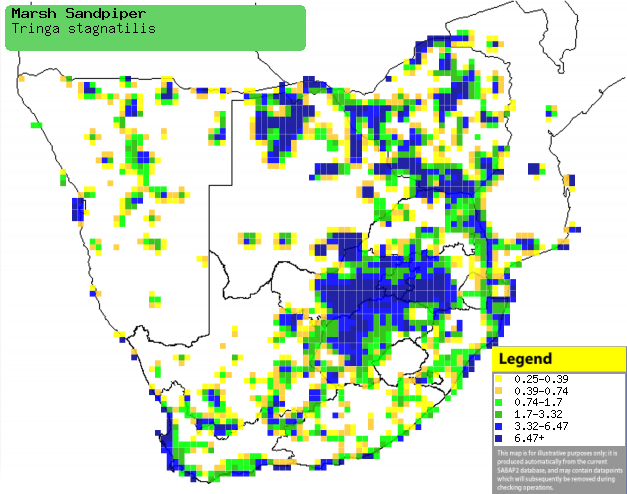|
Tringa stagnatilis (Marsh
sandpiper)
Moerasruiter [Afrikaans]; Poelruiter [Dutch]; Chevalier
stagnatile [French]; Teichwasserläufer [German]; Perna-verde-fino [Portuguese]
Life
> Eukaryotes >
Opisthokonta
> Metazoa (animals) >
Bilateria >
Deuterostomia > Chordata >
Craniata > Vertebrata (vertebrates) > Gnathostomata (jawed
vertebrates) > Teleostomi (teleost fish) > Osteichthyes (bony fish) > Class:
Sarcopterygii (lobe-finned
fish) > Stegocephalia (terrestrial
vertebrates) > Tetrapoda
(four-legged vertebrates) > Reptiliomorpha > Amniota >
Reptilia (reptiles) >
Romeriida > Diapsida > Archosauromorpha > Archosauria >
Dinosauria
(dinosaurs) > Saurischia > Theropoda (bipedal predatory dinosaurs) >
Coelurosauria > Maniraptora > Aves
(birds) >
Order: Charadriiformes > Family: Scolopacidae
Distribution and habitat
Breeds in Europe from roughly 50-120° East and Siberia,
heading south in the non-breeding season to the area from Australia through
India to sub-Saharan Africa from Mauritania to Eritrea south to southern Africa.
Here it is fairly common in large patches of the region, largely absent from
Mozambique and the arid Kalahari. It generally prefers coastal lagoons, saline
wetlands, temporary pools in river flood plains or salt-marshes and muddy
fringes of open water bodies.
|
 |
|
Distribution of Marsh sandpiper in southern Africa,
based on statistical smoothing of the records from first SA Bird Atlas
Project (©
Animal Demography unit, University of
Cape Town; smoothing by Birgit Erni and Francesca Little). Colours range
from dark blue (most common) through to yellow (least common).
See here for the latest distribution
from the SABAP2. |
Movements and migrations
It mainly arrives in southern Africa in the
period from September-November, departing between January and March,
earlier than most other waders.
Food
It mainly eats insects and their larvae, especially
chironomids and
coleopterans, supplemented with molluscs, crustaceans and polychaetes. It
does most of its foraging in shallow water, plucking prey from the surface or
sweepings its bill from its bill from side to side before snapping it shut.
Threats
Not threatened, although it may be particularly vulnerable
to botulism.
References
-
Hockey PAR, Dean WRJ and Ryan PG 2005. Roberts
- Birds of southern Africa, VIIth ed. The Trustees of the John Voelcker
Bird Book Fund, Cape Town.
|
